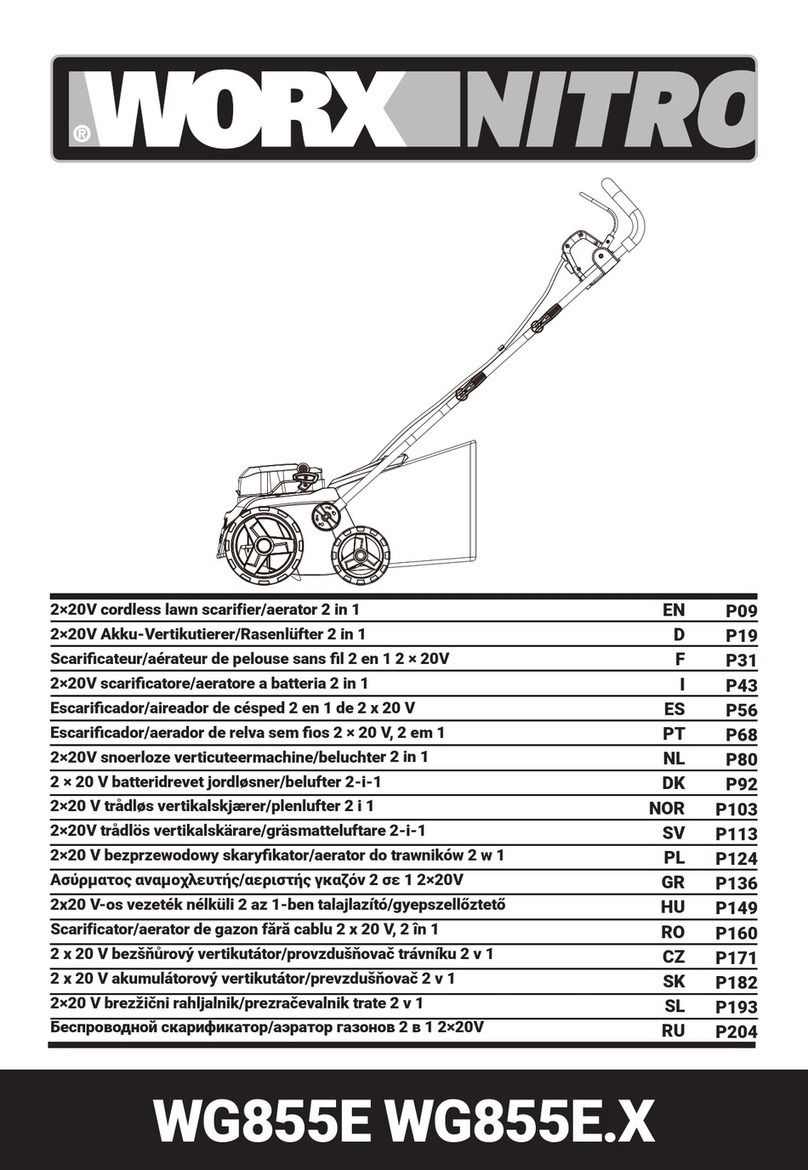
8
2x20V Dethatcher EN
keys, nails, screws or other small metal objects,
that can make a connection from one terminal
to another. Shorting the battery terminals
together may cause burns or a re.
6. Under abusive conditions, liquid may be ejected
from the battery; avoid contact. If contact
accidentally occurs, ush with water. If liquid
contacts eyes, additionally seek medical help.
Liquid ejected from the battery may cause
irritation or burns.
7. Do not use a battery pack or appliance that is
damaged or modied. Damaged or modied
batteries may exhibit unpredictable behavior
resulting in re, explosion or risk of injury.
8. Do not expose a battery pack or appliance to re
or excessive temperature. Exposure to re or
temperature above 130°C may cause explosion.
9. Follow all charging instructions and do
not charge the battery pack or appliance
outside of the temperature range specied
in the instructions. Charging improperly or at
temperatures outside of the specied range may
damage the battery and increase the risk of re.
10. Have servicing performed by a qualied repair
person using only identical replacement parts.
This will ensure that the safety of the product is
maintained.
11.Do not modify or attempt to repair the appliance
or the battery pack (as applicable) except as
indicated in the instructions for use and care.
ADDITIONAL SAFETY
WARNINGS FOR YOUR
LAWN DETHATCHER
a) Do not expose the machine to rain or wet
conditions. Water entering the machine will
increase the risk of electric shock
b) Do not use the machine in bad weather
conditions, especially when there is a risk of
lightning. This decreases the risk of being struck
by lightning.
c) Thoroughly inspect the area for wildlife where
the machine is to be used. Wildlife may be
injured by the machine during operation.
d) Thoroughly inspect the area where the machine
is to be used and remove all stones, sticks,
wires, bones, and other foreign objects. Thrown
objects can cause personal injury.
e) Before using the machine, always visually
inspect to see that the tines and the tines
assembly are not worn or damaged. Worn or
damaged parts increase the risk of injury.
f) Check the catcher frequently for wear or
deterioration. A worn or damaged catcher may
increase the risk of personal injury.
g) Keep guards in place. Guards must be in
working order and be properly mounted. A guard
that is loose, damaged, or is not functioning
correctly may result in personal injury.
h) Keep all cooling air inlets clear of debris.
Blocked air inlets and debris may result in
overheating or risk of re.
i) While operating the machine, always wear
non-slip and protective footwear. Do not operate
the machine when barefoot or wearing open
sandals. This reduces the chance of injury to the
feet from contact with the moving tines.
j) While operating the machine, always wear long
trousers. Exposed skin increases the likelihood
of injury from thrown objects.
k) Do not operate the machine in wet grass. Walk,
never run. This reduces the risk of slipping and
falling which may result in personal injury.
l) Do not operate the machine on excessively
steep slopes. This reduces the risk of loss of
control, slipping and falling which may result in
personal injury.
m) When working on slopes, always be sure of your
footing, always work across the face of slopes,
never up or down and exercise extreme caution
when changing direction. This reduces the risk
of loss of control, slipping and falling which may
result in personal injury.
n) Use extreme caution when reversing or pulling
the machine towards you. Always be aware
of your surroundings. This reduces the risk of
tripping during operation.
o) Hold the machine by insulated gripping surfaces
only, because the tines may contact hidden
wiring Tines contacting a “live” wire may make
exposed metal parts of the machine “live” and
could give the operator an electric shock.
p) Do not touch tines and other hazardous moving
parts while they are still in motion. This reduces
the risk of injury from moving parts.
q) When clearing jammed material or cleaning
the machine, make sure all power switches
are off and the battery pack is disconnected.
Unexpected operation of the machine may result
in serious personal injury.
SAFETY WARNINGS FOR
BATTERY PACK
a) Do not dismantle, open or shred cells or battery
pack.
b) Do not expose battery pack to heat or re. Avoid
storage in direct sunlight.
c) Do not short-circuit a battery pack. Do not store
battery packs haphazardly in a box or drawer
where they may short-circuit each other or be
short-circuited by conductive materials.
When
battery pack is not in use, keep it away from other
metal objects, like paper clips, coins, keys, nails,




























